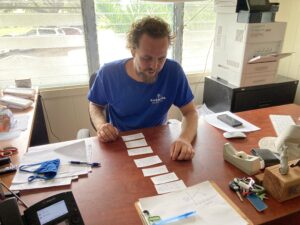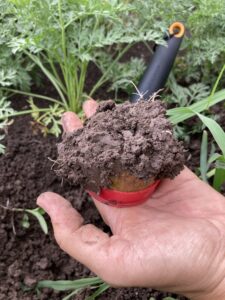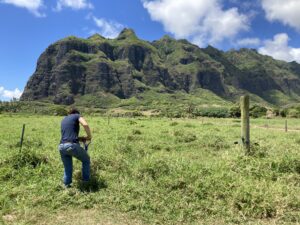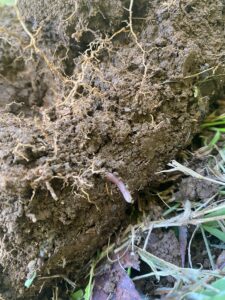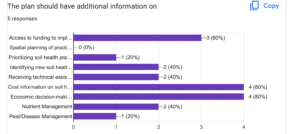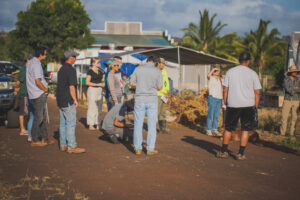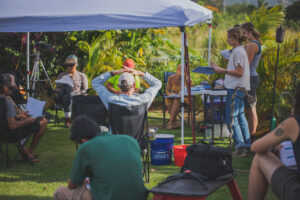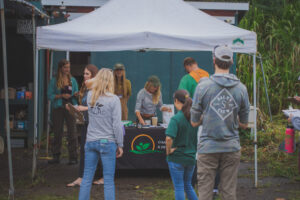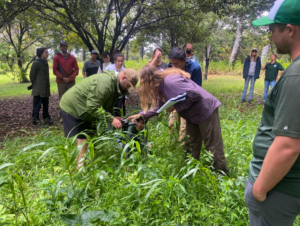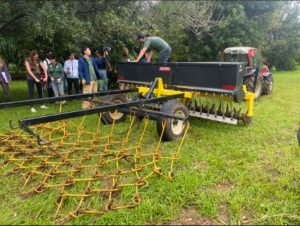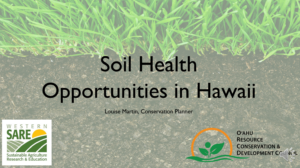Final report for OW20-354
Project Information
Building soil health is paramount to maintain farm productivity in the face of global challenges such as drought, intense storms, increased greenhouse gas emissions, and limited resources such as water and nutrients. Hawai‘i's unique island landscapes and history of soil degradation through intensive crop production heighten the importance of rebuilding soil health. As organic matter and soil nutrients are depleted, farm operations require greater quantities of fertilizers and water to sustain production and experience increased risk of crop failure due to less climate-resilient soils. Though conservation planning and federal farm bill programs provide a framework to identify and address natural resource concerns on agricultural lands, the pressing concern of how to build and maintain healthy, productive soil on agricultural lands is lost in a morass of competing concerns. In contrast, farmers are prioritizing soil health and seeking tools to address the need.
Our project team will evaluate Soil Health Plans (SHP) as a focused planning methodology that identifies spatially-referenced practices to benefit soil health on the farm-scale. Participating producers will guide decisions to identify new and underutilized soil health opportunities for their operations' crops and natural resources and any bottlenecks to their implementation. The project will utilize soil health testing to inform producers of the impact of practices already in use by their operations and provide support for implementation of soil health practices. The developed plans and refined planning methodology will educate producers and generate momentum for more farmers and ranchers to build resiliency through increased soil health.
Note: The agreement for this project was signed in January, 2021; project activities began on that date and the timeline for activities shifted accordingly. The following report covers activities from the start date of 1/11/2021 through 3/31/2021.
- Develop Soil Health Plans (SHP)
-
- Purpose: Evaluate the use of SHPs to provide producers with a tool that identifies opportunities to build soil health through the implementation of practices such as cover crops, tree establishment, or mulch application
- Action: Work with five (5) producers to organize site visits and discussions with the project team to understand producer goals for the landscape
- Action: Work with each producer to develop a farm-specific SHP that includes existing and proposed conservation practices supporting soil health
- Purpose: Evaluate the use of SHPs to provide producers with a tool that identifies opportunities to build soil health through the implementation of practices such as cover crops, tree establishment, or mulch application
- Evaluate impacts of soil health practices
-
- Purpose: Encourage further adoption of practices by measuring the potential impacts of soil health practices at each unique site and to establish baseline soil health data for each producer
- Action: Conduct soil testing at paired locations with and without conservation practices
- Action: Determine baseline soil health differences by soil data analysis
- Action: Producers provide feedback on the effects of soil health practices
- Purpose: Encourage further adoption of practices by measuring the potential impacts of soil health practices at each unique site and to establish baseline soil health data for each producer
- Technical assistance in SHP implementation
-
- Purpose: Support on-the-ground learning for producers to install soil health practices
- Action: Provide technical recommendations/assistance on at least one practice for installation to addressing soil health concerns on the land
- Purpose: Support on-the-ground learning for producers to install soil health practices
- Identify challenges to the adoption of soil health practices
-
- Purpose: Survey producers to determine the non-environmental impacts of implementing soil health practices and identify challenges to the adoption of SHP practices
- Action: Conduct a post-collaboration survey with producers geared towards evaluating perspectives of the economic and agronomic costs and benefits of soil health practices
- Action: Identify opportunities and challenges for future development of plans based on feedback provided
- Purpose: Survey producers to determine the non-environmental impacts of implementing soil health practices and identify challenges to the adoption of SHP practices
- Share project findings with the agricultural stakeholders
-
- Purpose: Educate a larger audience on strategies to restore depleted soils. Demonstrating the successes and lessons learned in this project will support others’ work on restoring soil health throughout Hawai‘i
- Action: Host outreach activities and report project findings on a variety of platforms (one-on-one and stakeholder meetings, on-farm workshops, webinar, factsheet, newsletters, and social media).
- Purpose: Educate a larger audience on strategies to restore depleted soils. Demonstrating the successes and lessons learned in this project will support others’ work on restoring soil health throughout Hawai‘i
Cooperators
- - Producer
- - Technical Advisor
- - Technical Advisor
- - Producer
- - Producer
- - Producer
- - Producer
Research
Project materials and methods for each objective are included in the following sections:
Soil Health Plan Development
Soil Health Plans (SHP) draw on a variety of tools and organizations including Oahu RC&D’s 808Planner, California Healthy Soils Initiative, Carbon Cycle Institute, Food and Agriculture Organization of the United Nations, and Natural Resources Conservation Service (NRCS). Nationally recognized conservation practices (e.g. cover crops, tree establishment, and mulch application) are evaluated and selected to address soil health improvement. The project team will work with producers to identify opportunities to effectively expand the use of these practices in the field as well as to identify the potential for new practices to be adopted by conducting site visits and gathering insights from participating farmers and ranchers. Conversations with producers in the initial phases of this project will help the researchers build rapport and better understand the operation goals and how they may relate to soil health. While the soil health plans will follow a template of pre-determined components (see below), additional information (such as including a list of prioritized recommendations of practices) may be included to better support the interests of producers receiving plans and representative of what is useful for growers across the state.
Components of a SHP:
- Cover page and farm/ranch characterization: name, location, acreage, operation, planner name, etc.
- Existing and Proposed Practices: identifying current and new soil health practices, acreage, operation & maintenance considerations, management strategies, etc.
- Maps
- Current Management / Existing Soil Health Practices Map
- Proposed Soil Health Practices Map
- Soil Testing Map (identifying locations of soil testing)
- Other Maps (Location, Soil taxonomy, Elevation, Annual Precipitation)
- Discussion/Highlights/Notes
Materials required:
GPS, ArcGIS software, Microsoft Office
Evaluate Impacts of Soil Health Practices
Soil health practices may impact the soil ecosystem via many mechanisms such as encouraging a more diverse microbial community, improving soil structure, or adding organic matter. For example, cover crops may supply nutrients such as nitrogen to the next crop, reduce soil erosion through stabilization and protection from the elements, and break up compacted soils via their roots which improves water infiltration and creates habitat for soil organisms. At each producer’s property, soil sampling will occur in an area of established soil health practice and of no existing soil health practice. Materials and collection methods will follow standard soil sampling protocols of Hubanks et al. regarding soil health analysis in Hawaii. Samples will be analyzed by a contracted laboratory for total carbon, bulk density, and microbial activity. With two soil samples for each producer, this is a total of ten soil samples. Producers will be asked to share observations and anecdotal feedback on practices included in their SHP.
Technical Assistance in SHP implementation
Methods of providing assistance will consist of one-on-one meetings with project team members that have received training in practice installation. The team member on site will help identify the most practical soil health practice for implementation based on current property goals and limitations. Technical assistance will be provided to farms and ranches throughout the duration of the project and feedback provided by producers will ensure the SHP is well understood.
Identify challenges to the adoption of soil health practices
A producer survey will be used to generate quantitative values of their perspectives on benefits and challenges of soil health practice implementation through the use of survey styles such as likert scales. The development process will draw upon previously conducted surveys through Oahu RC&D to select the format most appropriate for our audience. The survey analysis, designed to generate number values, will help the project team identify which opportunities and conflicts are most pressing to address for future SHP implementation.
Share project findings with the agricultural stakeholders
To share information with various agricultural stakeholders we will host a suite of outreach events and information dispersal. Workshops will be hosted at two of the producer locations (one on Oahu and one on Big Island) to reach a greater number of interested participants. These days will be organized by our experienced project team, who hosted a total of eight workshops in 2018. This project will use our wide network of social media and organization subscribers to distribute event information as well as findings of this work. At each outreach event, we will provide a before and after evaluation survey of participant learning. Analysis of these surveys will provide us with data on the amount of new information distributed to our community as well as insight for areas of interest for future outreach.
The content of soil health management plans diverged from the goals of carbon farm plans. Soil health management plans focus on maintaining or enhancing the soil’s capacity to function as a living ecosystem, while maintaining or improving production, by addressing the four soil health management principles: minimize disturbance, maximize soil cover, maximize biodiversity and maximize the presence of living roots. Carbon Farm plans include a focus on opportunities for terrestrial carbon sequestration to address climate change through soils and vegetation. Soil health management plans are a current, tangible opportunity for farmers and ranchers in Hawaii, as a result of new NRCS-PIA programming, while there are no state or local level incentive programs currently for carbon farm plans.
Our Post-collaboration Survey of the five participating producers to determine the non-environmental impacts of implementing soil health practices and identify challenges to the adoption of SHP practices identified clear benefits and barriers of soil health practices. Most farmers felt the soil health practices support the soil as well as plant health/productivity. All farmers shared that economic and labor support is needed to implement soil health practices. Additional barriers include limited availability of desired inputs.
The soil health plan template, which had pre-determined components from NRCS, was also evaluated. Most participating producers , 4 out of 5, indicated that beneficial additions to the soil health plan would include: information on localized costs to implement soil health practices and economic decision making tools to facilitate prioritization of changes to land management practices. We shared these result outcomes with researchers at University Hawaii as well as State Staff of NRCS. Oahu RC&D seeks to develop costing tools to provide economic decision making support as well as proving costing information to NRCS-PIA to justify raising their cost-share rates on soil health practices.
To quantitatively evaluate the effects of soil health practices, we sent soil samples to the Crow lab of University Hawaii who developed a soil health test comprised of 9 indicators. Some of these indicators are highly reactive to current site conditions while others are more static. Continued studies are also needed to make soil health testing a reliable and informed tool to provide assessments and recommendations of management practices.
Research outcomes
Education and Outreach
Participation summary:
3/31/21 Update
The outreach in progress has consisted of engagement with five (5) anticipated producers to confirm interest in participation, as well as planning initial consultations with project researchers. All five producers have signed "Farmer Agreement" documents, committing to collaboration on the project and planned deliverables. In March of 2021, two of the five initial consultations were held (one in person, one virtually) to review with each participant the soil health management planning process.
Pictured above, Christian of Kahumana Farms converses with the project coordinator about soil health and discusses priority interests in soil health planning.
12/31/21 Update
All five of the initial consultations to review the soil health planning process and discuss priorities were completed. Staff met with all producers to conduct site visits on each farm and review current and historical management, identify new soil health practices, and discuss operation and maintenance considerations. In field soil health assessments were completed and soil samples for laboratory testing were collected and sent to the UHM Crow Soil Ecology & Biogeochemistry Lab for Soil Health analysis. The soil health test, which analyzes chemical, physical and biological indicators, differs from a traditional soil fertility test which focuses on the nutrient-supplying power of soil. The first drafts of soil health management plans have been completed for each producer. Erosion modeling estimates, which demonstrate the effect proposed practices will have on erosion, were completed for each plan using RUSLE II. Results from laboratory analysis are expected to be returned in early 2022, and second drafts of soil health management plans will follow shortly.
Plans will be reviewed with the producers to identify which components of the plan provide valuable insights to their operation. This information will be shared with NRCS who is in the process of establishing procedures for soil health management plans in the pacific island area (Code 116: Conservation Planning Activity, Soil Health Management Plan; Code 162: Design and Implementation Activity, Soil Health Management ). We are working with producers to host a demonstration of soil health practices identified in their respective soil health plans.
Images from site visits to vegetable (left), pasture (center), and orchard (right) production systems to conduct in field soil health assessments and collect soil samples for laboratory analysis.
Final Update
All five soil health plans were completed and reviewed with the producers to discuss soil health test results and practice recommendations. Producers participated in a post collaboration survey to evaluate the cost and benefits of soil health practices and challenges they see in adoption of soil health practices as well as assessing the usefulness of soil health plans as a tool for supporting soil health. The top barriers identified were financial in nature with all participants at least citing one of the following as a barrier to implementation: funding, land access, time, and difficulties sourcing labor. Full responses to the survey in pdf format are attached here, Post-collaboration Survey.
Images from post collaboration survey, attached above.
Two workshops were held at host sites, one on Oahu and one on Hawaii island. Implementation of carbon amendment and cover cropping practices were demonstrated at these in-person workshops while the host farmers also shared their perspectives on soil health. Collectively 33 attendees learned about soil health plans, assessing soil health, and received hands-on learning via a soil health practice installation demonstration from the team members and participating farmers. These workshops were shared in our monthly newsletter and on social media. Local agricultural professionals from University of Hawaii extension and from the Natural Resources Conservation Service participated in and attended our workshops.
On Oahu, 18 local farmers and agricultural professionals attended a workshop highlighting soil carbon amendments as soil health practices. Oahu RC&D team members and University Hawaii extension agents spoke on properties of soil amendments and soil nutrient cycling. Oahu RC&D worked with the producer to set up a biochar trial which was toured at the workshop.
Pictured above, photos from Oahu workshop focused on soil carbon and cycling of nutrients
On Hawaii, despite unexpected hurricane weather, 15 guests attended the workshop. Oahu RC&D team members and University Hawaii faculty spoke on the benefits of cover cropping. We demonstrated using an AerWay Orchard Aerator and Cover Crop Seeder to plant a cover crop seed mix in an established macadamia nut orchard and conducted an in field soil health assessment as a group to consider soil health resource concerns present in the orchard. All evaluations received indicated interest in soil health planning and likeliness to use the information they learned. Attendees reported similar barriers to soil health implementation as the farmers who participated in our project. Video of the AerWay Orchard Aerator and Cover Crop Seeder demo was shared on social media.
Images from workshop on Hawaii Island, conducting In-Field Soil Health Assessment and demo of AerWay Orchard Aerator and Cover Crop Seeder
Project findings were shared with participating farmers and additional one-on-one stakeholder meetings were held with members from University Hawaii, NRCS field offices, and NRCS state office staff to discuss the progress and outcomes of this project.
One webinar was distributed through our newsletter, social media, and placed onto our website. It shares our project results and bolsters the momentum building behind soil health by informing producers and ag professionals of local opportunities to participate in soil health planning.
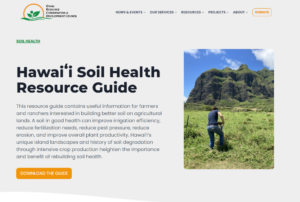 One guidance document document was distributed via our newsletter, social media, and placed on our website. It contains information on soil health management plans; soil testing services; online and in-field tools for Farmers; practices to support soil health; sourcing carbon locally; University Hawaii Publications, Researchers, and Extension Agents; and Non-profits & Funding Programs for Farmers Interested in Soil Health.
One guidance document document was distributed via our newsletter, social media, and placed on our website. It contains information on soil health management plans; soil testing services; online and in-field tools for Farmers; practices to support soil health; sourcing carbon locally; University Hawaii Publications, Researchers, and Extension Agents; and Non-profits & Funding Programs for Farmers Interested in Soil Health.
We shared our work on this project through 10 Social Media posts and 3 newsletter announcements which are attached here as media in a pdf format, WSAREsocialmedia & newsletterWSARE . A video of the AerWay Orchard Aerator and Cover Crop Seeder in action during out workshop demo received the most views, at 690. This is an effective method to gain awareness of our work in the community and highlight local producers who are innovating agriculture in Hawaii.
Final Update
All five soil health plans were completed and reviewed with the producers to discuss soil health test results and practice recommendations. Producers participated in a post collaboration survey to evaluate the cost and benefits of soil health practices and challenges they see in adoption of soil health practices as well as assessing the usefulness of soil health plans as a tool for supporting soil health. The top barriers identified were financial in nature with all participants at least citing one of the following as a barrier to implementation: funding, land access, time, and difficulties sourcing labor. Full responses to the survey in pdf format are attached here, Post-collaboration Survey.
Images from post collaboration survey, attached above.
Two workshops were held at host sites, one on Oahu and one on Hawaii island. Implementation of carbon amendment and cover cropping practices were demonstrated at these in-person workshops while the host farmers also shared their perspectives on soil health. Collectively 33 attendees learned about soil health plans, assessing soil health, and received hands-on learning via a soil health practice installation demonstration from the team members and participating farmers. These workshops were shared in our monthly newsletter and on social media. Local agricultural professionals from University of Hawaii extension and from the Natural Resources Conservation Service participated in and attended our workshops.
On Oahu, 18 local farmers and agricultural professionals attended a workshop highlighting soil carbon amendments as soil health practices. Oahu RC&D team members and University Hawaii extension agents spoke on properties of soil amendments and soil nutrient cycling. Oahu RC&D worked with the producer to set up a biochar trial which was toured at the workshop.
Pictured above, photos from Oahu workshop focused on soil carbon and cycling of nutrients
On Hawaii, despite unexpected hurricane weather, 15 guests attended the workshop. Oahu RC&D team members and University Hawaii faculty spoke on the benefits of cover cropping. We demonstrated using an AerWay Orchard Aerator and Cover Crop Seeder to plant a cover crop seed mix in an established macadamia nut orchard and conducted an in field soil health assessment as a group to consider soil health resource concerns present in the orchard. All evaluations received indicated interest in soil health planning and likeliness to use the information they learned. Attendees reported similar barriers to soil health implementation as the farmers who participated in our project. Video of the AerWay Orchard Aerator and Cover Crop Seeder demo was shared on social media.
Images from workshop on Hawaii Island, conducting In-Field Soil Health Assessment and demo of AerWay Orchard Aerator and Cover Crop Seeder
Project findings were shared with participating farmers and additional one-on-one stakeholder meetings were held with members from University Hawaii, NRCS field offices, and NRCS state office staff to discuss the progress and outcomes of this project.
One webinar was distributed through our newsletter, social media, and placed onto our website. It shares our project results and bolsters the momentum building behind soil health by informing producers and ag professionals of local opportunities to participate in soil health planning.
 One guidance document document was distributed via our newsletter, social media, and placed on our website. It contains information on soil health management plans; soil testing services; online and in-field tools for Farmers; practices to support soil health; sourcing carbon locally; University Hawaii Publications, Researchers, and Extension Agents; and Non-profits & Funding Programs for Farmers Interested in Soil Health.
One guidance document document was distributed via our newsletter, social media, and placed on our website. It contains information on soil health management plans; soil testing services; online and in-field tools for Farmers; practices to support soil health; sourcing carbon locally; University Hawaii Publications, Researchers, and Extension Agents; and Non-profits & Funding Programs for Farmers Interested in Soil Health.
We shared our work on this project through 10 Social Media posts and 3 newsletter announcements which are attached here as media in a pdf format, WSAREsocialmedia & newsletterWSARE . A video of the AerWay Orchard Aerator and Cover Crop Seeder in action during out workshop demo received the most views, at 690. This is an effective method to gain awareness of our work in the community and highlight local producers who are innovating agriculture in Hawaii.
Education and Outreach Outcomes
Farmers and workshop participants reported appreciating the opportunity to engage on soil health concepts, connect with agricultural service providers, and have hands on learning opportunities. From our evaluations, community members enjoy and asked for us to do additional workshops. Opportunities to see what other local farmers are trying and having success with enhances the likeliness of greater practice adoption.
In order for soil health planning be a consistent, financially supported tool NRCS-PIA needs TSP's that will be qualified to provide technical assistance on soil practices and develop plans. Upon recognizing this need, Oahu RCD&D is in a subsequent project to recruit local agricultural service providers to complete NRCS training. This project and workshop participation has helped to justify that there is interest from the community in soil health planning and financial support to implement soil health practices.
We shared our work on this project through 10 Social Media posts and 3 newsletter announcements which are attached here as media in a pdf format, WSAREsocialmedia & newsletterWSARE . A video of the AerWay Orchard Aerator and Cover Crop Seeder in action during out workshop demo received the most views, at 690. This is an effective method to gain awareness of our work in the community and highlight local producers who are innovating agriculture in Hawaii.
